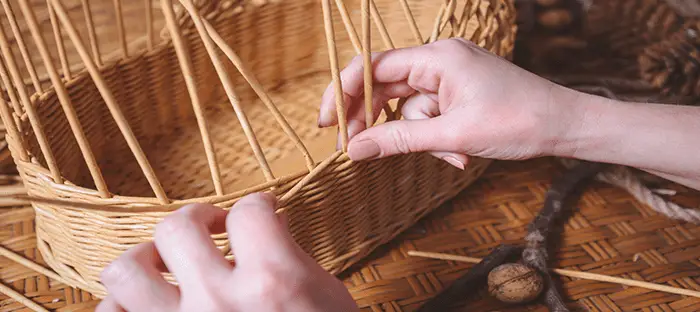
Basket weaving is an art that has been around for many years. It even came before the introduction of cloth making and pottery. Historians have discovered basket weaving proofs on stone carvings from way back 20,000 years BC. There were pieces of evidence proving that people around that time resort to barks, roots, rush, brambles, straw, vines, leaves, oaks, bamboo, and hazel for basket weaving.
This article will take a deeper dive on the basket weaving history.
Basket weaving history
Basket weaving history started with the strong beliefs of our ancient people. Ancient Mesopotamians believe that baskets are the offsprings of the gods and also one of the main foundations of the earth. In order to create the landmasses on earth, they strongly believed that the gods placed wicker rafts on the bodies of water, and this is where the soil was placed to form the landmasses.
On the other hand, baskets are also associated with baby Moses in the bible. As we all know, baby Moses reached safety as he was placed in a basket made up of mud and bulrushes.
The ancient Egyptian bakers utilize baskets to store or display freshly baked bread, while Romans created baskets out of willows. Asian people like Chinese and Japanese also consider basket weaving as an art.
There are many shreds of evidence that baskets have been a great part of history. It has been a center of religious beliefs and has provided ease in everyday life of our aborigines. However, the main credit of the basket weaving history goes to the Native Americans. Around 5000 to 1000 BC, Indians living in New Mexico and Arizona created pottery. They have unknowingly started basket weaving first while only intending to use them as molds for the pots. These are mostly woven by their women using raw materials.
The basket weaving trend extended to their other everyday tools, such as cooking utensils, fishing nets, and animal snares. Different tribes had their versions, but most are made out of natural or dyed delicate fibers.
The baskets made by Native Americans became popular as decorations; however, there aren’t many knowledgeable people who can do them anymore. The Philippines was taken over by the United States during the Spanish-American war around 1898, and the basket weaving history continued. Filipinos also have their basket weaving techniques and materials. This fact, combined with the United States’ need for baskets during that time, led to the opening of schools specializing in basket weaving. Not long after, the graduates from the schools became teachers as well, solidifying the Philippine basket weaving industry for local and international exports.
Designs and raw materials used

Baskets are mostly made of natural materials. Native Americans started the basket weaving history with willows, roots, native grasses, and twigs. Nowadays, rattan is used in place of the native fibers, while raffia is used in place of the native grasses. The design of the basket depends upon the fibers utilized. It can be extended or limited as weaving patterns and techniques become involved.
It is challenging to get a hold of the exact native materials used by ancient people a long time ago, but dyes are used to emulate the colors of native baskets. It could be concentrated cloth dyes or vegetable dyes. However, rattan is not suitable for dyeing.
Beaters, saws, knives, awls, and planes are also needed to hammer and bend the materials. Depending on the design or pattern, thread and tapestry needles may also be required. Fibers should also be soaked on a tub. Rattan is usually worked on while its fibers are still moist.
Basket manufacturing process

The manufacturing process is heavily influenced by basket weaving history. There are no equipments who can emulate the beauty of hand-woven ones, which is why baskets still have the personal touch until now. Below are the steps in making it dating back from years ago.
Step 1:
The design or pattern to be followed should be chosen carefully while considering the size and shape to be created. This is a tricky part as the materials to be used should also be taken into consideration. Some fibres require soaking or dyeing before the coiling or weaving process.
Step 2:
Whatever design or pattern is chosen, any basket is created starting from the base part.
If the design or pattern requires a wood base, it should be shaped first before holes are drilled. The sides of the basket will originate from these holes. Spokes resembling rods should be laid out as the bottom part. These other rods are woven beneath and under the spokes. The rods at the bottom part should be strong enough to support the basket, while the ones being woven in and out of the spokes should be thinner, lighter, and more flexible.
Step 3:
The same spokes forming the base will also form the sides. The spokes should be cut in such a way that it will be adequate to become the sides. After completing the base part, soak the spokes to make them softer. Use pliers to bend and turn it up to become the sides.
The sides can also be created by combining base spokes and weavers. This is the technique where the weavers are woven beneath and under the spokes. The spokes should be larger than the weavers to create that perfect balance. The spokes’ ends should be soaked. It will be used as a border for the basket’s top part. This is also where it is locked into the sides of the basket.
Step 4:
Now that you’ve got the base part and sides, it is time to create the handles. The reed to be used as handle should be chosen carefully. It should be smooth, strong, and durable. Like the spokes, the ends of the reed should also be soaked in water. It should overlap into the basket’s sides so it is secured.
Step 5:
Having a lid is optional. It is easy to do as it is exactly how a base is done. The only difference is that it must correspond to the size of the sides for aesthetic purposes.
You may also take a look at these videos to see the basics yourself:
Knowing the basket weaving history helps us appreciate the industry more. It is not only a profitable industry that helps the economy of many countries, but it also provides livelihood to a lot of basket weavers out there. Basket weavers are also special as not everyone has the skills to create a single basket. It requires patience, time, and effort to master. Sadly, the basket weaving industry held back for a bit due to the introduction of plastic, which is easier to make with the aid of equipment. There is also a shortage of basket weavers and sources of natural materials nowadays. Buying and using baskets will not only support and make the industry great again, but you can also help the environment and preserve an amazing history. After all, nothing beats anything lovingly created with hands.
